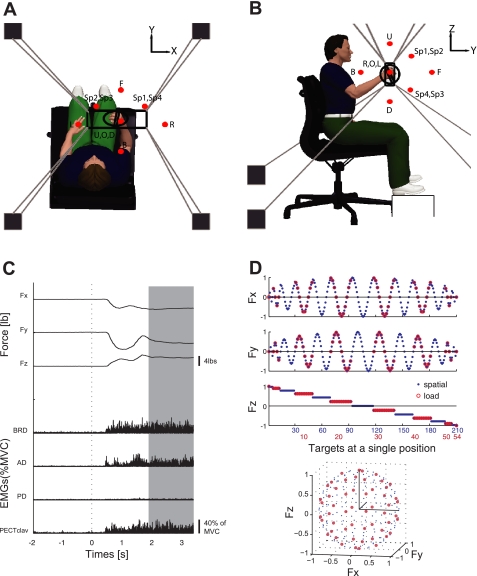Fig. 1.
Experimental setup, exemplary target matching trial, and target force directions for the spatial and load protocols. A and B: top and lateral views of the experimental setup. Hand position and 3-dimensional (3-D) forces generated at the hand were recorded using the Multi-Axis Cartesian-based Arm Rehabilitation Machine (MACARM) cable robot. The MACARM is comprised of a spatial array of motors (indicated by black squares), which are connected to a central end-effector via cables (depicted by gray lines). The end-effector incorporates a gimbaled handle, the bar in the middle of an oval around the subject's right hand (A), mounted on a 6-degree-of-freedom load cell. The coordinate system for position and force measurements is indicated in the right upper corner. Hand positions used for the protocols are indicated by red-filled circles. The spatial and load protocols were performed in a central hand position (O), while all 11 hand positions were evaluated during the position protocol. Descriptions of the 11 hand positions are: backward (B), forward (F), left (L), right (R), down (D), and up (U). The remaining 4 targets were located in 4 quadrants with specific coordinates (Sp1–Sp4). C: for each trial, 3-D forces (Fx, Fy, Fz) and electromyographic (EMG) data from 8 arm and shoulder muscles were collected. [Representative EMGs for brachioradialis (BRD), anterior and posterior fibers of deltoid (AD and PD, respectively), and the clavicular fibers of pectoralis major (PECTclav) muscles are shown.] Data recorded during 1.5 s of stable force generation (shaded area) were used for further analyses. MVC, maximum voluntary contractions. D: the 210 (blue dots) and 54 (red-unfilled circles) target force directions in the 3-D force space for the spatial and load protocols, respectively. The trial numbers along the x-axis are color matched with the force target of the 2 protocols in the Cartesian coordinate. Force directions for the load protocol were a subset of those used for the spatial protocol. The force directions were homogeneously distributed in 3-D force space to avoid bias.

